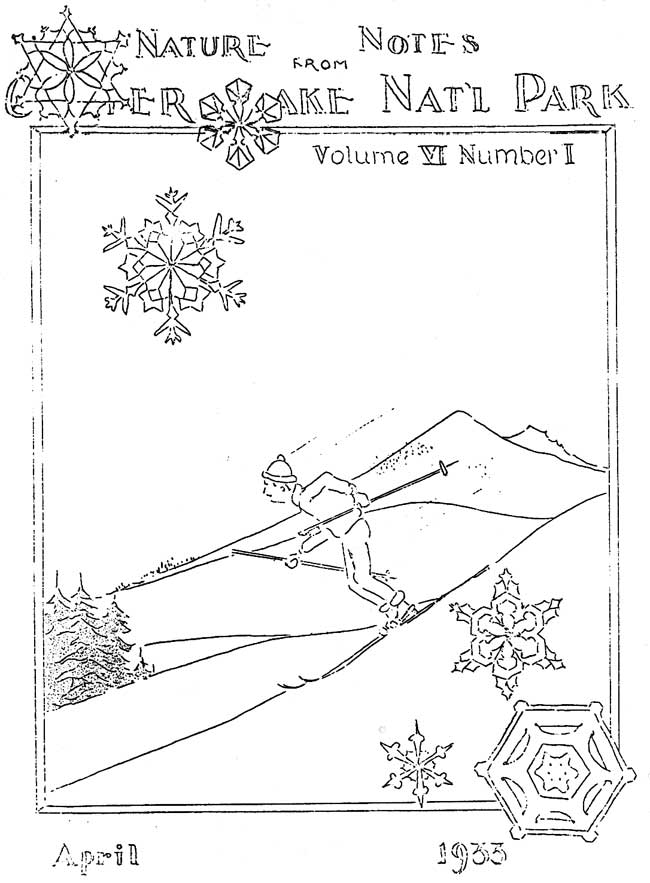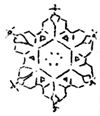Volume 6 No. 1 – April 1, 1933
All material courtesy of the National Park Service.These publications can also be found at http://npshistory.com/
Nature Notes is produced by the National Park Service. © 1933.
The Crystal Gems of Crater Lake in Winter
By D. S. Libbey
Would that each of you could spend a time in the silent grandeur of Crater Lake in the dead of winter. After a heavy, moist snowfall, the boughs of the conifer trees are garbed in beauty. Crater Lake National Park, on the crest of the Cascade Range, is located in the realm of snow flakes, the crystal forms of frozen water. The intricate filigree work and the myriad forms showing snow sculpture everywhere depict “Gaywas” (the picturesque Indian name for Crater Lake) in fairyland attire.
Literally, as one sees the snow flakes so abundantly developed at Crater Lake in winter, he realizes that there is no art comparable to Nature’s art and no beauty that can approach the handiwork of Nature. As Lowell says in verse so familiar: “Every tree twig is bedecked with crystals, rimmed inch deep with pearl”.
The cover design, as well as the margin of this page, shows treasures of the snow. Snow flakes are among the most evanescent of all Nature’s creations. They are unique and precious particularly so since they are fleeting forms and cannot be preserved like other gems.
Examine the sketches and you will discern that the snow flake crystals are formed with six faces, being of the true hexagonal system. Of course, all snow flakes are not perfect crystals and all gradations between shapeless amorphous masses to the intricate hexagonal filigree designs are found. No two snow flake crystals are exact duplicates. If one is interested in studying crystal forms and is prepared to make micro-photographs of these fleeting crystals, one has in every new photographic reproduction a thrill, for each may possess more beauty and complexity than the previous.
The avocation of collecting reproductions of snow flake crystal forms has a practical side as well as a pleasurable one which is vicarious in its nature. Artists, designers, architects and interior decorators frequently draw from snow crystal designs the foundation for the creation of bizarre and unique sketches and reproductions. One who collects such photographs does not find that every snow storm produces perfect, beautiful specimens.
It appears that ideal conditions for crystal growth are dependent upon a very fine adjustment of correct temperature, air currents, and rate of formation. The wind conditions in the sky cause the forming snow to be driven and forced against other fleecy particles, the delicate forms are destroyed. The arrangement of the freezing water molecules and the crowding against one another cause lack of symmetry in crystal formation. There is little doubt but that Crater Lake National Park is an area affording an ideal place to study and see the development of snow forms and crystal aggregates.
“The beautiful is as useful as the useful”
— Victor Hugo
Crater Lake in Winter
By Charles H. Simson, Permanent Park Ranger
One of the questions frequently asked by the multitude of visitors from all over the world who come each summer to view Crater Lake is “How much snow falls?” “How does it accumulate?” and “What are the winter conditions?” They are impressed by the scenic grandeur of the lake and its unique setting. After experiencing the beautiful colors of this bluest of blue lakes framed in the jagged and precipitous multi-colored lava and pumice slopes, and garlanded around the rim by the jade green fringe of hemlock and pine, the visitor wonders as to the transformation which winter time brings.
The opportunity is now offered for you to visit this scenic marvel while it is still wrapped in its winter cloak of white, at a time when the maximum accumulation of snow occurs. Curiously the greatest snow depth comes after spring has arrived down in the valleys and all living things have felt the thrill which comes with the recurrent throb of renewed life.”The Frost Flowers” of winter, which replaced the blossoms of summer time, still remain. The tree boughs are bent under the burden of snow and ice masses and appear like giant plumes frosted with a fleecy covering of iridescent jewels.As a result of the winter-long operation of the snow plow the highways will be opened early in April and you are invited to visit Crater Lake. You will drive through miles of snow-walled highway to reach the Rim and view this magic land, sparkling under the rays of a brilliant sun. It is your opportunity to see for yourself how this unique scenic wonder, the rare jewel of the National Park system appears after the heavy snows of a long and severe winter.On April 1, 1933 – 727″ or 60′ 7″ of snow had fallen since last October. This is 65-1/2 inches or 5 feet 5-1/2 in. more than had fallen at the same date for the previous year and the snowfall for the winter of 1931-32 was the greatest on record. If the snowfall for the balance of the year to any degree approaches a normal fall there will be a greater accumulation this year than last. The comparative snow fall figures for the winters of 1931-32 and 1932-33 by months are as follows:
|
1931-1932 |
1932-33 |
|||||
| September
October November December January February March April May Total |
3 31 114 151-1/2 182 69 111 91 38 790-1/2 |
inches “ “ “ “ “ “ “ “ “ |
September
October November December January February March |
— 33 61 156 256 130 |
inches “ “ “ “ “ |
|
From the above it is evident that only 63-1/2 inches of snow will have to fall during April and may to equal the total snow fall for last year. It appears very probable that the record-breaking snow fall of last season amounting to 65 feet 10-1/2 inches, will be exceeded.
The maximum accumulation of snow on the ground at any one time last season was 13 feet 10 inches at Headquarters. This consisted of packed snow and ice and the peak was reached during April. Since April 1 this year, we had a depth of 13 feet 9 inches at Park Headquarters, it appears that when it is deemed safe to permit cars inside the park, early in April, the visitors will find an equal or greater snow accumulation.
Crater Lake will present a marvelous picture to our early season visitors. The mysterious and weird forms which have been taken on by the various two and three story utility buildings, checking stations and the Park Headquarters building, are grotesque and fascinating. It is indeed a magic land which beckons to you, sparkling under the lustre of Nature’s wonderful mantle of white. Come lovers of winter sports – skiiers and toboganners – you will find a play ground that equals your fondest dreams. Above all you have the lure of seeing Crater Lake, still bedecked in a diadem of snow covering the encircling cliffs.
* * * * * * * * * * * * * * *
Thirty-five inches of snow in one day.
February 15, 1993 will go down in the records very probably as the day of greatest snowfall for any one day of the winter of 1932-33. In the 24-hour period 35 inches of snow fell. The precipitation or water content amounted to 2.87 inches.
The Coldest day of the year in the park.
The lowest temperature recorded this winter occurred on the morning of February 9. The mercury dropped to 18 ° below zero. At Fort Klamath a temperature of 22 ° below occurred at the same time and at Medford the temperature was 18 ° above.





